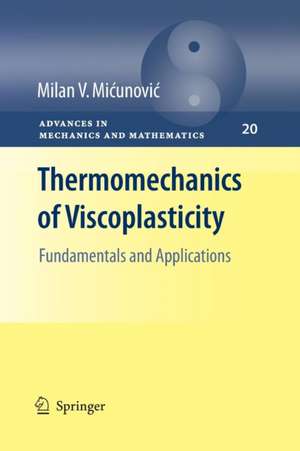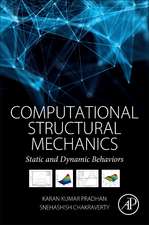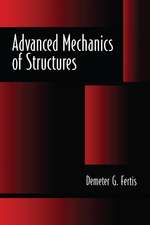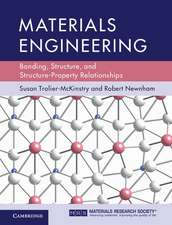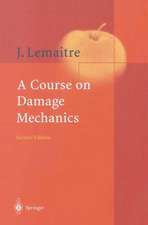Thermomechanics of Viscoplasticity: Fundamentals and Applications: Advances in Mechanics and Mathematics, cartea 20
Autor Milan Micunovicen Limba Engleză Paperback – 23 aug 2016
| Toate formatele și edițiile | Preț | Express |
|---|---|---|
| Paperback (1) | 782.70 lei 38-44 zile | |
| Springer – 23 aug 2016 | 782.70 lei 38-44 zile | |
| Hardback (1) | 948.16 lei 3-5 săpt. | |
| Springer – 28 apr 2009 | 948.16 lei 3-5 săpt. |
Din seria Advances in Mechanics and Mathematics
-
 Preț: 395.47 lei
Preț: 395.47 lei - 15%
 Preț: 699.96 lei
Preț: 699.96 lei - 18%
 Preț: 789.32 lei
Preț: 789.32 lei - 18%
 Preț: 1011.27 lei
Preț: 1011.27 lei - 18%
 Preț: 1006.06 lei
Preț: 1006.06 lei - 18%
 Preț: 951.91 lei
Preț: 951.91 lei - 18%
 Preț: 1388.36 lei
Preț: 1388.36 lei - 15%
 Preț: 649.54 lei
Preț: 649.54 lei - 18%
 Preț: 1224.68 lei
Preț: 1224.68 lei - 18%
 Preț: 1670.41 lei
Preț: 1670.41 lei - 15%
 Preț: 648.89 lei
Preț: 648.89 lei - 15%
 Preț: 641.85 lei
Preț: 641.85 lei - 15%
 Preț: 695.01 lei
Preț: 695.01 lei - 18%
 Preț: 962.81 lei
Preț: 962.81 lei - 15%
 Preț: 642.51 lei
Preț: 642.51 lei - 18%
 Preț: 968.82 lei
Preț: 968.82 lei - 18%
 Preț: 947.50 lei
Preț: 947.50 lei -
 Preț: 400.85 lei
Preț: 400.85 lei - 20%
 Preț: 559.19 lei
Preț: 559.19 lei - 20%
 Preț: 561.11 lei
Preț: 561.11 lei - 15%
 Preț: 644.18 lei
Preț: 644.18 lei - 24%
 Preț: 790.70 lei
Preț: 790.70 lei - 18%
 Preț: 965.52 lei
Preț: 965.52 lei - 15%
 Preț: 648.24 lei
Preț: 648.24 lei - 15%
 Preț: 700.61 lei
Preț: 700.61 lei
Preț: 782.70 lei
Preț vechi: 1029.87 lei
-24% Nou
Puncte Express: 1174
Preț estimativ în valută:
149.84€ • 154.18$ • 126.31£
149.84€ • 154.18$ • 126.31£
Carte tipărită la comandă
Livrare economică 25 februarie-03 martie
Preluare comenzi: 021 569.72.76
Specificații
ISBN-13: 9781493939589
ISBN-10: 1493939580
Pagini: 272
Ilustrații: XIX, 249 p.
Dimensiuni: 155 x 235 x 14 mm
Greutate: 0.39 kg
Ediția:2009
Editura: Springer
Colecția Springer
Seria Advances in Mechanics and Mathematics
Locul publicării:New York, NY, United States
ISBN-10: 1493939580
Pagini: 272
Ilustrații: XIX, 249 p.
Dimensiuni: 155 x 235 x 14 mm
Greutate: 0.39 kg
Ediția:2009
Editura: Springer
Colecția Springer
Seria Advances in Mechanics and Mathematics
Locul publicării:New York, NY, United States
Cuprins
Theoretical and Experimental Aspects.- Physical and Geometrical Background.- Crystalline Materials with Thermo-inelastic Memory.- Normality Rule? Plastic Work Extremals and Related Topics.- Thermodynamics of Inelasticity.- Some Multiaxial Viscoplastic Experiments: Relation to Tensor Functions.- Some General Problems.- Viscoplasticity of Ferromagnetics.- Self-Consistent Method and Quasi-Rate-Dependent Polycrystals.- Inelastic Micromorphic Polycrystals.- Applications of the Theory.- Plastic Wave Propagation in Hopkinson Bar.- Ratchetting Phenomenon at Low Strain Rates for AISI.- Stress and Strain Measures for Orthotropic Metals at Large Nonproportional Plastic Strain Histories.
Recenzii
From the reviews:“This book exposes in a concise manner the essentials of the modern theory of viscoplasticity in relation with its basic thermomechanical foundations … . In that sense the book represents a true … contribution to the field. … addresses professionals or younger readers (graduate students, PhDs, research engineers) who want to apprehend a difficult subject matter that pertains to both continuum mechanics … and its applications in materials science. … It is generally well and concisely written and … generously documented.” (Gérard A. Maugin, Mathematical Reviews, Issue 2010 c)
Textul de pe ultima copertă
This book contains geometrical and thermodynamical issues indispensable for development of a rational theory of thermoviscoplasticity. Geometrical picture of coupled thermomagnetomechanical histories of damaged solids is built both by means of Kroener's incompatibility approach as well by Eshelbian implanting eigenstrains. Duality of Euclidean anholonomic and non-Euclidean natural state space is also outlined in this book.
Damaged inelastic materials of differential type, discrete and infinitesimal memory are obtained from principle of thermo-inelastic memory. Issue of plastic spin is considered. Postulate of minimal plastic work and corresponding non-associativity 4-tensor are then used to show whether associativity of flow rule holds. Postulates of Drucker, Iliushin and Hill are discussed. Thermodynamics of inelasticity is extensively discussed in classical, rational, extended and endochronic version with account to statistical thermodynamics. A non-steady aging is used in endochronic thermodynamics to cover creep-pasticity coupled inelastic histories. Multiaxial dynamic experiments with cylindrical, ``bichierino'' and cruciform specimen from austenitic stainless steels are analyzed. Quasi-rate independence and Rabotnov's plastic delay is combined with tensor representation. Inelastic ferromagnetics are treated by means of extended as well endochronic thermodynamics. For low cycle fatigue the experimentally observed displacement of magnetic induction history with respect to stress history is analyzed.
Self consistent method applied to inelastic polycrystals is based on constrained micro-rotations and free meso-rotations. A special attention is devoted to slight disorder of polycrystal grains. The theory is confronted with classical J2-theory. Different inelastic multiaxial stress histories are analyzed and corresponding active slip systems determined. For numerical results micro quasi rate independence and relaxed Taylor's model are used. The theory of inelastic micromorphic polycrystals with couple stresses needs a very small number of necessary material constants. Nonproportionality of strain history as well as intergranular continuity are related to antisymmetry of stress tensor.
Key topics:
* Includes a detailed description of the geometry of thermo-deformation with local evolving natural state configuration
* Provides a comparative review of various models of thermodynamics (classical, rational, endochronic, statistical) with special approach to inelastic high speed histories
* Introduces quasi-rate independence and its application to plastic waves, ratcheting, and diffuse localization
* Explores the sensor representation approach to thermo-inelastic coupled fields connected to a generalized associativity of flow rule as well as a comparison with the J2-approach
* Examines micromechanics based on micro grain approach leading to reduced number of material constants
* Provides biaxial cruciform specimen Hopkinson bar results
* Reexamines the Hill’s yield function for nonproportional stress-thermo-strain histories
This book is intended for material science experts and professionals interested in impact experiments, continuum mechanics researchers, engineers in research institutes and graduate and Phd students aiming to apply FEM to calculate strength of structures at time varying thermo-mechanical excitations.
Damaged inelastic materials of differential type, discrete and infinitesimal memory are obtained from principle of thermo-inelastic memory. Issue of plastic spin is considered. Postulate of minimal plastic work and corresponding non-associativity 4-tensor are then used to show whether associativity of flow rule holds. Postulates of Drucker, Iliushin and Hill are discussed. Thermodynamics of inelasticity is extensively discussed in classical, rational, extended and endochronic version with account to statistical thermodynamics. A non-steady aging is used in endochronic thermodynamics to cover creep-pasticity coupled inelastic histories. Multiaxial dynamic experiments with cylindrical, ``bichierino'' and cruciform specimen from austenitic stainless steels are analyzed. Quasi-rate independence and Rabotnov's plastic delay is combined with tensor representation. Inelastic ferromagnetics are treated by means of extended as well endochronic thermodynamics. For low cycle fatigue the experimentally observed displacement of magnetic induction history with respect to stress history is analyzed.
Self consistent method applied to inelastic polycrystals is based on constrained micro-rotations and free meso-rotations. A special attention is devoted to slight disorder of polycrystal grains. The theory is confronted with classical J2-theory. Different inelastic multiaxial stress histories are analyzed and corresponding active slip systems determined. For numerical results micro quasi rate independence and relaxed Taylor's model are used. The theory of inelastic micromorphic polycrystals with couple stresses needs a very small number of necessary material constants. Nonproportionality of strain history as well as intergranular continuity are related to antisymmetry of stress tensor.
Key topics:
* Includes a detailed description of the geometry of thermo-deformation with local evolving natural state configuration
* Provides a comparative review of various models of thermodynamics (classical, rational, endochronic, statistical) with special approach to inelastic high speed histories
* Introduces quasi-rate independence and its application to plastic waves, ratcheting, and diffuse localization
* Explores the sensor representation approach to thermo-inelastic coupled fields connected to a generalized associativity of flow rule as well as a comparison with the J2-approach
* Examines micromechanics based on micro grain approach leading to reduced number of material constants
* Provides biaxial cruciform specimen Hopkinson bar results
* Reexamines the Hill’s yield function for nonproportional stress-thermo-strain histories
This book is intended for material science experts and professionals interested in impact experiments, continuum mechanics researchers, engineers in research institutes and graduate and Phd students aiming to apply FEM to calculate strength of structures at time varying thermo-mechanical excitations.
Caracteristici
Includes a detailed description of the geometry of thermo-deformation with local evolving natural state configuration A comparative review of various models of thermodynamics including classical, rational, statistical, and endochronic, with a special approach to inelastic high speed histories Provides a comparative review of various models of thermodynamics (classical, rational, endochronic, statistical) with special approach to inelastic high speed histories Introduces quasi-rate independence and its application to plastic waves, ratcheting, and diffuse localization A tensor representation approach to thermo-inelastic coupled fields connected to a generalized associativity of flow rule; includes a comparison with the J2 approach Discussion of Drucker, Iliushin, and Hill postulates; special attention devoted to the slight disorder of polycrystal grains Quasi-rate independence and its application to plastic waves, ratcheting and diffuse localization; Micromechanics based on the micro grain approach leading to a reduced number of material constants Especially useful to the emergent field of biomechanics Examines micromechanics based on micro grain approach leading to reduced number of material constants Provides biaxial cruciform specimen Hopkinson bar results Reexamines the Hill’s yield function for nonproportional stress-thermo-strain histories
